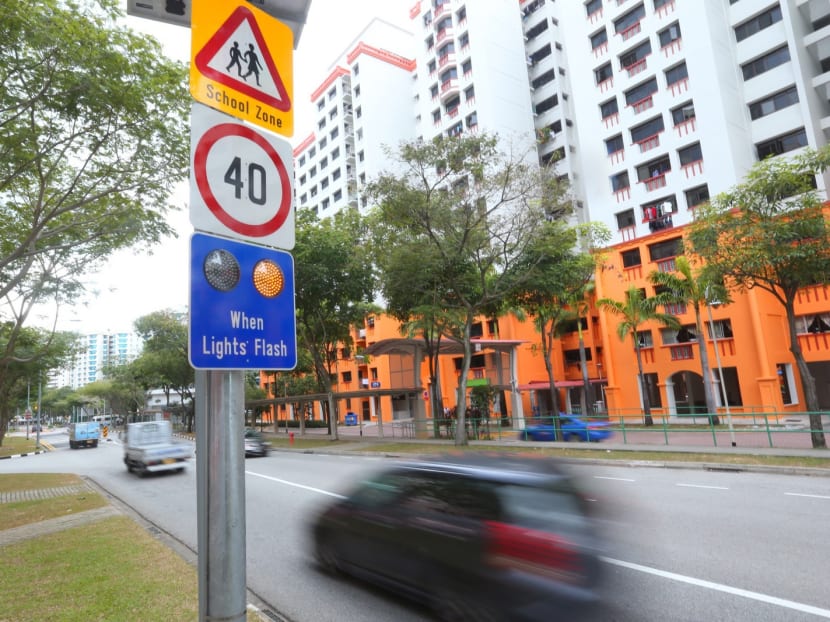Speed ‘the number one killer’ in urban areas: Road safety expert
LEIPZIG (Germany) — For modern, densely-populated urban cities like Singapore, the challenge when it comes managing urban transport is how to improve the safety of vulnerable road users such as cyclists, pedestrians and motorcyclists, who are competing to use the same road space.

The new road sign to remind motorists to slow down for pedestrians at zebra crossings, along Admiralty Drive. Photo: Ernest Chua
LEIPZIG (Germany) — For modern, densely-populated urban cities like Singapore, the challenge when it comes managing urban transport is how to improve the safety of vulnerable road users such as cyclists, pedestrians and motorcyclists, who are competing to use the same road space.
Pointing out that millions suffer from serious injuries incurred during road accidents, Ms Veronique Feypell, the International Transport Forum’s (ITF) expert on road safety said speed is “the number one killer” in urban areas. Authorities have to adopt a strict speed management policy where speed limits are adapted to the road infrastructure, and a clear classification of the road network’s usage.
Ms Feypell was speaking to reporters after a press conference that released figures from a study conducted by the International Traffic Safety Data and Analysis Group (IRTAD) – a working group of the Joint Transport Research Centre of the OECD and the ITF.
It found that the number of fatalities among car occupants fell by 54 per cent between 2000 and 2013, but the decreases were only 36 per cent for pedestrians, 35 per cent for cyclists and 22 per cent for motorcyclists. The number of motorcycle deaths increased between 2000 and 2007.
Ms Feypell noted that most Organisation for Economic Co-operation and Development (OECD) countries have a speed limit of no more than 120 to 130kmh for motorways with quality pavement and separated median barriers, 80kmh for rural roads, and in urban areas, no more than 50kmh, said Ms Feypell. In fact, OECD countries are increasingly adopting 30kmh as the default speed limit, with 50kmh as an exception for main streets in urban areas.
“You need to make sure that there is no collision between a car and a vulnerable road user at a speed where you cannot survive, or at a speed which will entail severe injuries. Basically when you have a mix of road users, the speed limit should not be above 30kmh,” she said.
The development of cities in most industrialised countries facilitate the movement of cars and this may not be the wisest strategy today. “We are going back to see how we can facilitate the movement of pedestrians…cyclists and power two-wheelers because they are also part of the transport system of a country,” she said, adding that while there have been technology advancement to make roads safer for cars, other road users have not enjoyed the same.
Road designers and policy makers should think of what can be done to make human errors on the road less fatal. Sweden, for example, is expanding the use of “two-plus-one roads” — three-lane roads with two lanes in the same direction and the third in the other — with barriers alternating to allow overtaking only in certain portions. While it is an expensive investment, the results are worthwhile, she added.
According to the IRTAD study, countries like Sweden, the United Kingdom, the Netherlands and Denmark continue to rank tops in keeping fatalities down. For example, Sweden and the UK recorded 2.7 and 2.8 fatalities per 100 000 inhabitants respectively in 2013.
This was attributed to implementation of systematic road safety strategies aimed at tackling main risk factors for traffic crashes such as speed, alcohol, and non-compliance with traffic rules, advancing technical standards for road infrastructure and vehicles, improved emergency and heath care, and economic conditions.
On the other hand, most non-European IRTAD members achieved a lower than average reduction in the number of road fatalities. For example in 2012, South Korea registered 17.2 road fatalities per billion vehicle-km — one of the highest among those surveyed — and 10.3 road fatalities per 100,000 in habitants.
Singapore is not a member of IRTAD, but the police’s Annual Road Traffic Situation report for last year stated that the number of fatal traffic accidents and fatalities continued to fall, with 149 cases of fatal accidents in 2014, compared to 150 cases in 2013.
The number of fatalities in Singapore also dropped slightly from 160 in 2013 to 154 last year. The fatality rate per 100,000 persons decreased from 2.96 in 2013 to 2.82 last year.
While it is unclear why a modern nation like South Korea has such high rates still, they are working with the ministers there to share the knowledge they have gained from across the world, said ITF Secretary-General Jose Viegas, adding that there is a “multiplicity of causes” that may have led to this result.






